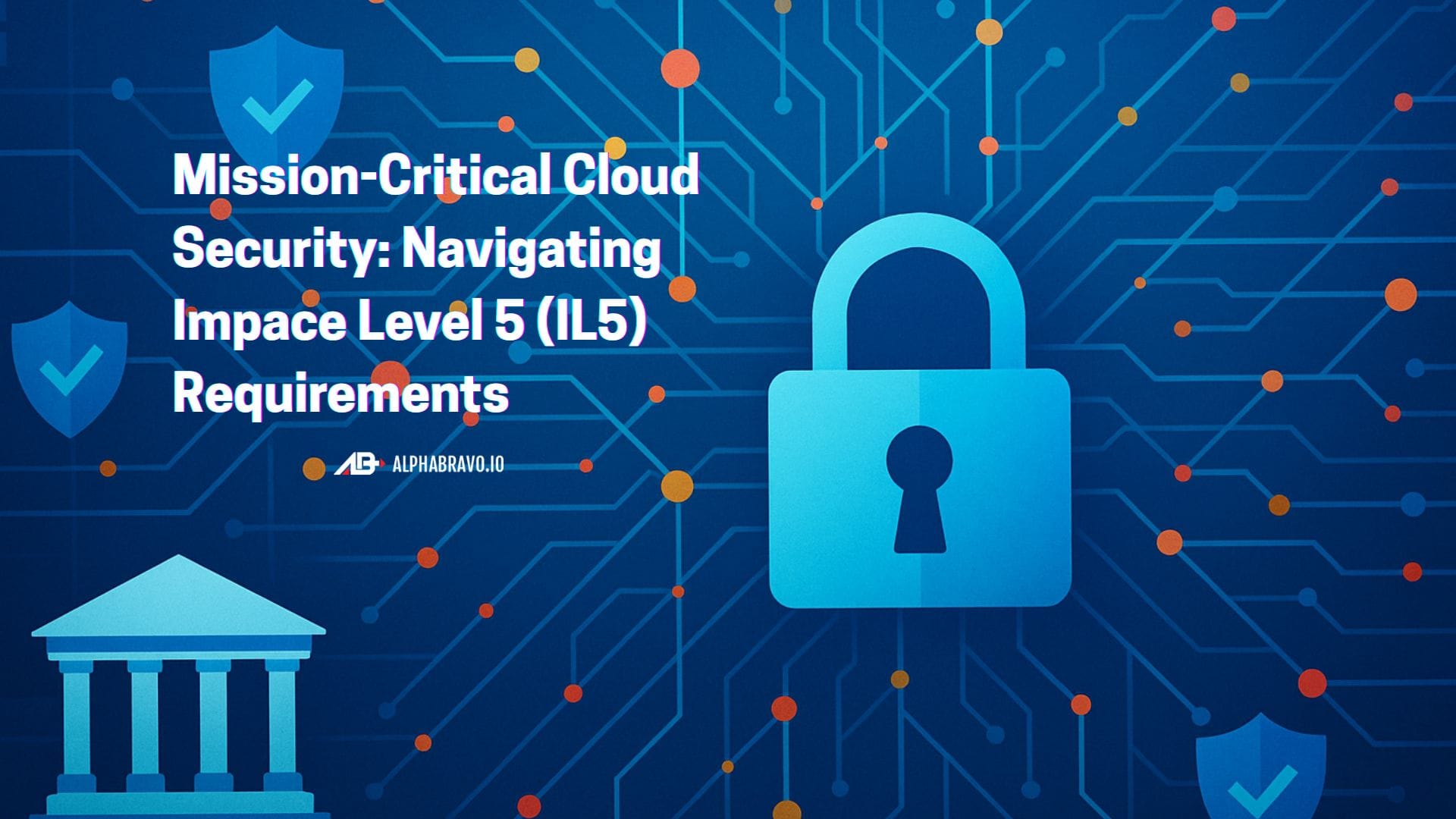Mission-Critical Cloud Security: Navigating Impact Level 5 (IL5) Requirements
Navigating IL5 means mastering one of the DoD’s most rigorous cloud security frameworks—balancing FedRAMP High, U.S.-only hosting, and total isolation to protect mission-critical CUI and National Security Systems from catastrophic compromise.

Impact Level 5 (IL5) represents one of the Department of Defense's most stringent security frameworks for cloud environments, protecting data that, if compromised, could cause catastrophic harm to national security. For organizations supporting defense missions, understanding IL5 requirements isn't just about compliance-it's about safeguarding critical information that underpins national security operations. This article explores the intricate world of IL5 cloud security, breaking down complex requirements into actionable insights for security professionals and decision-makers.
Understanding the IL5 Security Classification
Impact Level 5 (IL5) serves as a robust security framework designed to protect two specific types of sensitive information: unclassified National Security Systems (NSS) and Controlled Unclassified Information (CUI) requiring heightened protection beyond that of IL4 environments.
What Exactly Does IL5 Protect?
IL5 safeguards information that, while not classified, remains critically sensitive to national security interests. This includes:
-
Controlled Unclassified Information (CUI) requiring stronger protections than IL4 provides. This encompasses sensitive data across multiple categories including critical infrastructure, defense, export control, intelligence, financial operations, and more. CUI represents information that, if compromised, could significantly impair mission capabilities or create substantial financial damage.
-
National Security Systems (NSS) which support intelligence activities, cryptologic operations, military command and control, and equipment integral to weapons systems. These systems form the backbone of defense operations and require specialized protections even when handling unclassified data.
IL5 in the Impact Level Hierarchy
The Department of Defense Cloud Computing Security Requirements Guide (SRG) establishes a clear hierarchy of impact levels:
- IL2: Publicly releasable information
- IL4: Controlled Unclassified Information (CUI)
- IL5: Higher sensitivity CUI and unclassified National Security Systems
- IL6: Classified information up to SECRET level
This progressive scale reflects the increasing sensitivity of information and the corresponding security controls required. Unlike IL4, IL5 specifically addresses mission-critical systems whose compromise could severely impact military operations, intelligence activities, or national security functions.
Core Security Requirements for IL5 Compliance
IL5 compliance builds upon the foundation of FedRAMP High authorization, adding specialized controls tailored to defense environments. The comprehensive framework encompasses technical controls, personnel requirements, and physical safeguards working in concert to protect sensitive information.
Security Control Framework
IL5 environments must implement an extensive set of security controls:
-
FedRAMP High Baseline + DoD-Specific Controls: Starting with FedRAMP High's 421 security controls, IL5 adds 23 DoD FedRAMP+ controls, bringing the total to 444 security controls. These additional requirements address defense-specific concerns not fully covered by standard FedRAMP protocols.
-
Enhanced Authentication Mechanisms: Controls require rigorous multi-factor authentication, privileged access management, and role-based access controls specifically calibrated for defense environments.
-
Comprehensive Encryption Requirements: All data must be encrypted both at rest and in transit using NSA-approved cryptographic solutions like AES-256, ensuring information remains protected throughout its lifecycle.
Personnel and Geographic Restrictions
IL5 imposes strict requirements on who can access systems and where data can reside:
-
U.S. Personnel Only: All personnel with administrative access or management responsibilities must be U.S. citizens who have undergone appropriate background screening. This restriction extends to all staff with significant system access, including engineers, administrators, and security personnel.
-
U.S.-Based Infrastructure: All data and processing must remain within U.S. territory, with systems physically located in secured facilities within the United States. This geographic constraint ensures data remains under U.S. legal jurisdiction and physical protection.
Isolation Requirements
One of IL5's defining characteristics is its strict isolation mandates:
-
Physical Separation: IL5 environments require physical separation from non-DoD and non-federal government tenants. This means the underlying hardware cannot be shared with commercial or public cloud tenants.
-
Logical Segregation: While virtual/logical separation between DoD and other federal government tenants is permitted, there must be clear boundaries preventing potential cross-contamination.
-
Network Segmentation: Robust network segmentation with intrusion detection systems, advanced firewall configurations, and encrypted communication channels must be implemented to prevent lateral movement within systems.
Implementation Strategies for IL5 Environments
Successfully implementing an IL5-compliant environment requires specialized infrastructure, tools, and processes designed specifically for high-security defense workloads.
Specialized Cloud Infrastructure
Standard commercial cloud environments cannot meet IL5 requirements without significant modifications:
-
Air-Gapped Cloud Regions: Cloud service providers offer specialized regions like AWS GovCloud (US) or Azure Government Defense that provide the physical and logical separation required for IL5 workloads. These environments are physically and logically isolated from commercial cloud infrastructure.
-
Dedicated Hardware: In many cases, dedicated hosts running specialized security-hardened configurations are required to ensure complete isolation from other tenants. For example, the Air Force's Next Generation GPS Operational Control System required over 200 dedicated hosts running more than 1,000 individual virtual machines to meet IL5 requirements.
-
Security Architecture: Implementation requires comprehensive design of network segmentation, intrusion detection systems, and robust firewall configurations specifically tailored to defense workloads.
Advanced Security Controls
IL5 environments leverage sophisticated technical controls beyond standard cloud security:
-
NSA-Approved Encryption: All data encryption must use algorithms and key lengths approved by the National Security Agency, with AES-256 being the minimum standard for sensitive information. This encryption must be implemented for data at rest, in transit, and often for data in use.
-
Advanced Identity Management: Implementation requires sophisticated identity and access management systems with multi-factor authentication, privileged access management, and role-based controls specifically calibrated for defense environments.
-
Secure DevOps Practices: Organizations must implement secure coding practices, automated security testing, and comprehensive vulnerability management to prevent security weaknesses throughout the development lifecycle.
Continuous Monitoring and Compliance
IL5 environments require perpetual vigilance through specialized monitoring tools:
-
Real-Time Threat Detection: Continuous monitoring using ACAS (Assured Compliance Assessment Solution) and HBSS (Host Based Security System) tools provides real-time visibility into system security status.
-
Security Information and Event Management (SIEM): Advanced SIEM solutions help identify and mitigate threats quickly, processing vast amounts of security telemetry to detect potential intrusions or anomalies.
-
Automated Compliance Validation: Automated tools continuously validate that all 444 security controls remain properly implemented and effective, generating required compliance documentation for ongoing authorization.
Challenges and Strategic Considerations
Implementing and maintaining IL5 compliance presents significant challenges that organizations must strategically address.
Cost and Resource Implications
IL5 environments require substantial investment:
-
Increased Infrastructure Costs: Specialized cloud regions with dedicated hardware typically cost 30-40% more than standard commercial cloud environments. This premium reflects the additional security, isolation, and compliance capabilities provided.
-
Personnel Requirements: Organizations need specialized security personnel with appropriate clearances and training to manage IL5 environments, adding significant operational costs beyond the technology itself.
-
Continuous Compliance Investment: Maintaining ongoing compliance requires dedicated resources for monitoring, testing, documentation, and remediation of any identified issues.
Technical Complexity
The technical requirements of IL5 environments introduce significant complexity:
-
Specialized Expertise: Organizations need security professionals with specialized knowledge of both cloud technologies and defense security requirements-a relatively rare combination of skills.
-
Integration Challenges: Connecting IL5 environments with other systems while maintaining compliance boundaries requires careful architectural design and implementation.
-
Innovation Constraints: The stringent security requirements can limit the adoption of new technologies until they've been thoroughly evaluated and approved for defense use.
Future-Proofing IL5 Implementations
As threats evolve, IL5 requirements will continue to adapt:
-
Emerging Threats: Organizations must stay vigilant regarding emerging threat vectors, particularly as quantum computing advances potentially threaten current encryption standards.
-
Evolving Standards: The DoD Cloud Computing SRG undergoes periodic revisions to address new threats and technologies, requiring organizations to adapt their implementations accordingly.
-
AI and Machine Learning Integration: Advanced security monitoring increasingly leverages artificial intelligence and machine learning to detect sophisticated threats targeting defense systems. These technologies are becoming essential components of effective IL5 security postures.
The Strategic Value of IL5 Compliance
For organizations supporting defense missions, IL5 compliance delivers substantial strategic advantages beyond mere regulatory adherence. It enables participation in mission-critical defense initiatives, establishes credibility in the defense technology ecosystem, and provides a framework for protecting an organization's most sensitive information.
The standardized approach offered by IL5 certification streamlines authorization processes across defense agencies, allowing certified environments to be leveraged for multiple missions without duplicative security assessments. This efficiency is particularly valuable as defense agencies accelerate their adoption of cloud technologies for sensitive workloads.
Looking ahead, organizations should view IL5 compliance not as a one-time achievement but as an ongoing journey requiring continuous adaptation to evolving threats and requirements. By embracing this mindset and investing in the necessary expertise and infrastructure, organizations can successfully navigate the complexities of IL5 requirements while delivering secure, mission-enabling cloud capabilities to defense customers.
In this ever-evolving landscape of advanced threats and sophisticated defense requirements, IL5 stands as a critical framework enabling the secure migration of sensitive workloads to cloud environments-balancing the operational benefits of cloud computing with the non-negotiable security demands of national defense.

